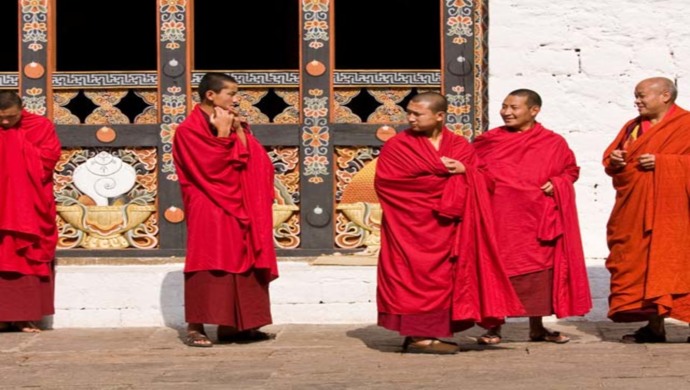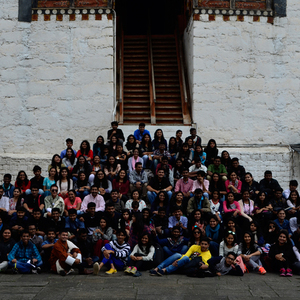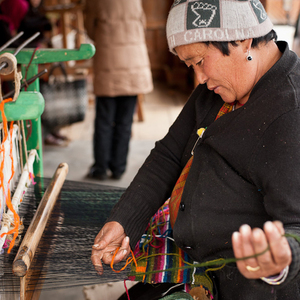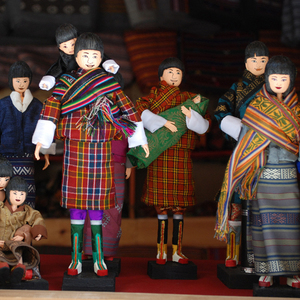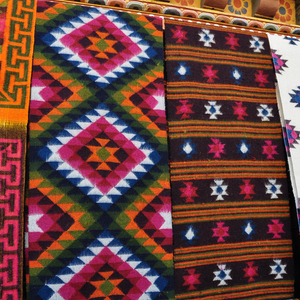Day 1. Arrive Paro:
Altitude of Paro 2,280 m
Your flight to Paro on a clear day, is marked with the panoramic views of the Himalayas including the Everest and other famous Peaks. The approach through the foothills and the landing (including few steep turns) at the tiny airstrip of Paro has been termed as adventurous by many travelers. After the completion of immigration formalities at the Paro Airport exit door, you will be received by your Bhutanese guide with traditional “Tashi Khadar” a white scarf symbolic of good luck and fortune. Thereafter you are driven to your hotel and do your check in. After lunch, you visit the following
- Paro Rimpung Dzong, also known as Fortress of the heap of jewels, built during the time of Shabdrung Ngawang Namgyal in 1646
- Ta Dzong, an ancient watch tower overlooking Rimpung Dzong built in 1951 now converted into national museum.
In the evening visit the Bhutanese textile and handicraft shops around the Paro Town and have your first introduction to the Bhutanese textiles.
Meals – Lunch and Dinner; Overnight at the Hotel in Paro.
Day 2. Paro Sightseeing:
After breakfast, start your day with a hike to
- Taktsang Monastery (Tiger's nest), the abode of gods and monks situated at an altitude of 3100m on the Upper Paro Valley, Bhutan. As per the legend, Guru Padmasambhana (Guru Rinpoche), the tantrum mystic who brought Buddhism to Bhutan, came in the form of Dorje Droloe riding a flying tigress to subdue the demon that was obstructing the spread of Buddhism in the Himalayas.
After the completion of the hike, you would be served picnic Lunch among the woods. After lunch, visit
- Kyichu Lhakhang, one of the oldest monasteries in Bhutan built in the 7th century by the Tibetan Emperor Songtsen Gampo.
Then visit a traditional textile weaving factory. Interact with the weavers.
Meals – Breakfast, Lunch and Dinner; Overnight at the Hotel in Paro.
Day 3. Paro - Thimphu:
Driving Distance: 65 Kms, Driving Time: 1.50 hrs. - 2 hrs, Altitude of Thimphu: 2280
After breakfast, drive to Thimphu. On the way visit
- Visit Tamchog Lhakhang, located along Paro-Thimphu highway on the base of a mountain across the Pa Chhu river built in the early 15th century by the great iron bridge builder Thangtong Gyalpo.
On arrival in Thimphu, check in to your hotel. After lunch, visit
- Textile Museum was established in the year 2001 and has a good collection of exclusive and antique Bhutanese textile artifacts. The museum was set up with an objective to promote encourage weavers to continue the weaving of traditional Bhutanese textile, Promote Bhutan in the field of textile art and to preserve and promote the history and tradition of Bhutan. (Closed on weekends and Govt. Holidays)
- Institute for Zorig Chusom where Students are taught the 13 traditional arts and crafts of Bhutan in this institute. One of the 13 Arts is Tshem Zo which is the art of working with needles, threads and other necessary items to make clothes, boots, thangkas, and other items used for decorations and other household needs. (Only on working days and when the institute is not on breaks. This institute is closed on weekends, Govt. Holidays and institute vacations).
- National Memorial Chhorten, a Stupa built in 1974 to honor the third Druk Gyalpo, Jigme Dorji Wangchuck. Every morning till night old people and young people circumambulate the Chhorten.
- Kuensel Phodrang, the gigantic Buddha Dordenma Statue located atop a hill in Kuensel Phodrang Nature Park.
In the evening, visit the
- Tashichhodzong, or ‘the fortress of the glorious religion’. Initially erected in 1641 by Shabdrung Ngawang Namgyal, it was rebuilt in the 1960s during the reign of Bhutan’s third king in the traditional style, without plans or nails. It houses some ministries, His Majesty’s secretariat, and the central monk body and opens after 5 PM.
Later return to the hotel for Dinner.
Meals – Breakfast, Lunch and Dinner; Overnight at the Hotel in Thimphu.
Day 4. Thimphu - Punakha/Wangdue:
Driving Distance: 76 Kms, Driving Time: 2.50 hrs. – 3 hrs. Altitude of Punakha: 1310 m.
After breakfast and completion of Check Out formalities you are driven to Punakha/Wangdue, for your next leg of the tour. On the way, you would stop at
- Dochula Pass, lies at an elevation of 3,150 m and is a great place to view the higher Himalayas. The landmarks around the pass includes 108 Druk Wangyal Stupas built under the patronage of Queen Ashi Dorji Wangmo Wangchuk
After arrival at Punakha, check in to the hotel. After lunch, you would visit
- Punakha Dzong, built in 1637 by Shabdrung Ngawang Namgyal. For many years until the time of the second King, it served as the seat of the Government. It is still the winter residence of Je-Khenpo (The Chief Abbot of the Central Monastic Body of Bhutan)
- Chhimi Lhakhang, a famous Temple, which is also known as “The Temple of Fertility” built by Lama Drukpa Kuenley
Evening free for leisure activities.
Meals – Breakfast, Lunch and Dinner; Overnight at the Hotel in Punakha/Wangdue.
Day 5. Punakha - Phobjikha :
Driving distance: 70 Kms, Driving time: 2.50 hrs. Altitude of Phobjikha: 2900 m.
After breakfast check out of your hotel and drive to Wangdue. While in Wangdue, visit
- Rinchengang Village. This is a small cluster village in Wangduephodrang, on a hill opposite to where Wangduephodrang Dzong was built before. It is about 20 minutes hike uphill from the nearest road.
Continue your drive to Gangtey. On arrival in Gangtey, proceed for lunch. While in Gangtey, visit
- Gangtey Goemba, an important monastery of Nyingmapa school of Buddhism, the main seat of the Pema Lingpa tradition. The present Abbot, Kunzang Pema Namgyal is the ninth re-incarnation. It is one of the the largest Nyingma monastery in Bhutan.
- Phobjikha Valley, one of the most beautiful glacial valleys in the Himalayas. It lies at an elevation of 3,000 m. It is surrounded by a large village inhabited mainly by the families of the 140 Gomchens who take care of the monastery. Phobjikha is best known for the rare black necked cranes that migrate here from the Tibetan Plateau to avoid the extremely cold winters. Visit the local weavers and interact with them, you may try weaving for yourself.
Meals – Breakfast, Lunch and Dinner; Overnight at the Hotel in Phobjika/Gangtey.
Day 6. Phobjikha - Trongsa:
Driving Distance: 120 Kms, Driving Time: 4.50 hrs – 5 hrs. Altitude of Trongsa: 2300 m.
After breakfast, drive to Trongsa. On the way stop at the Pelela Pass (Altitude: 3300 m) and then the
- Chendbji Chhorten, built during the 18th century by Lama Shida in the style of the great Boudhanath Chhorten of Nepal to cover the remains of an evil spirit which is said to have manifested as a gigantic snake.
Lunch at Chendbji and then drive further to Trongsa. Enroute stop for lunch. While in Trongsa, visit
- Trongsa Dzong, the seat of power over Central and Eastern Bhutan. It was built by Chogyal Minjur Tempa was later enlarged at the end of the 17th century by Desi Tenzin Rabgay. Trongsa Dzong is the ancestral home of the present Royal Family. The first two hereditary kings ruled Bhutan from this Dzong.
- Ta Dzong, an ancient watch tower built in the year 1652 by Chogyal Minjur Tempaa as per the directions of Shabdrung Ngawang Namgyal. It has been converted into a museum and represents a tasteful blend of tradition and modernity.
Later, you are driven to the hotel. Evening free for leisure.
Meals – Breakfast, Lunch and Dinner; Overnight at the Hotel in Trongsa.
Day 7. Trongsa - Bumthang:
Driving Distance: 68 Kms, Driving time: 2.50 hrs - 3 hrs. Altitude of Bumthang: 2600 m.
After breakfast, drive to Bumthang. While in Chumey valley in Bumthang, visit the
- Yathra weaving factory - Yathra: It is the most famous textile product of Bumthang. The Chumey Valley is known for the beautiful Yathra woven by the locals. Yathra is a hand woven fabric made from the wool of sheep or Yak. The wool is first spun into threads and then dyed before they are woven into Yathra with beautiful flower patterns and colours. The Yathra cloth is made into scarfs, jackets, table cloths, bags, etc. Most of the women in this valley, especially in Zungye village earn their lively hood by weaving Yathra which is supplied to various towns in Bhutan.
Post Yathra Weaving factory, you are driven to your hotel. Lunch would be served on the way on in the hotel, depending on the schedule. In the evening you have the option of either exploring the Bumthang valley or relax at the hotel.
Meals – Breakfast, Lunch and Dinner; Overnight at the Hotel in Bumthang.
(Note: the roads to Bumthang are not good due road widening work going on)
Day 8. Bumthang Sightseeing:
After breakfast, you would be taken around the city to visit the
- Jakar Dzong, literally meaning the Castle of White Bird. The current structure was built in 1667. Jakar Dzong is now the main administrative center for Bumthang District, the Dzong also houses the regional monk body.
- Lamey Goemba, a large palace and monastery built in the 1800s by the first king Ugyen Wangchuk for his two nun sisters.
- Jambay Lhakhang, built by King Srongsen Gampo of Tibet in the 7th century and is one among the 108 monasteries built by him to subdue evil spirits in the Himalayan Region. October one of the most spectacular festival, “Jambay Lhakhang Drup” is staged here.
- Chakhar Lhakhang, literally meaning the Iron Castle. The original palace was made of Iron and hence the name “Chakhar”. It was rebuilt in 14th century by Dorji Lingpa, a Buddhist saint.
- Kurjey Lhakhang, named after body print of Guru Rimpoche. It consists of three temples. The first temple was built in the year 1652 on the rock face, where Guru Padmasambhava meditated in the 8th century. The second temple is considered to be the most holy as it is built on the site of the cave which contains the imprint of the Guru's body. In the year 1990, Ashi Kesang, the Queen mother built the third temple. All the three temples are surrounded by 108 chorten wall.
- Membar Tsho, also known as “The burning Lake”. It is one of the most sacred sites in the region and relates to the famous treasure revealer, Terton Pema Lingpa. Following a prophecy by Guru Rinpoche, Terton Pema Lingpa unearthed a treasure from the bottom of the lake. He dived into the lake with a burning butter lamp and reappeared with the butter lamp still burning and a chest and scroll of paper in his hand (treasures)
During the sightseeing, you would be taken to a local restaurant for lunch. After completion of sightseeing, drive back to the hotel. After relaxation you are served with dinner.
Meals – Breakfast, Lunch and Dinner; Overnight at the Hotel in Bumthang.
Day 9. Bumthang - Mongar:
Driving Distance: 190 Kms, Driving time; 7 hrs – 8 hrs. Altitude of Mongar: 1600 m.
After breakfast, drive to Mongar. Stop at places to view scenery and for photography. Drive from Bumthang to Mongar shall take you across the highest point in Bhutan’s motorable road. The point is known as the Thrumsingla Pass at an altitude of 4000 m. Picnic lunch on the way. On arrival, check in to the hotel. The evening ends exploring the Mongar town.
Meals – Breakfast, Lunch and Dinner; Overnight at the Hotel in Mongar.
Day 10. Mongar - Lhuntse:
Driving Distance: 78 Kms, Driving time: 3 hrs - 3.5 hrs. Altitude of Lhuntse: 1460 m
After breakfast, visit
- Mongar Dzong, which was rebuilt in 1953 and it is unique as it has two entrances. There are about 60 young monks residing in this Dzong. You will see the images of the Buddha of long life, as well as Guru Rinpoche and the Shabdrung. No drawings or nails have been used in building the Dzong
Then drive to Lhuntse. Enroute stop for lunch. Lhuntse is one of the most isolated and rural settlements in Bhutan. It is mostly covered by beautiful conifer and pine forests. The Kurtoe region is the ancestral home of the Royal family of Bhutan. One of the most picturesque sights in Lhuntse is
- Lhuntse Dzong, which lies on the eastern side of the Kuri Chhu (River), perched on a hill top. Originally a monastery was established by Kunga Wangmo in the year 1943. The formal Dzong was built in 1654 by the Trongsa Penlop Minjur Tempa after winning a battle. The Dzong was named Lhuntse Rinchentse.
Dinner and overnight in camp or a guest house in Lhuntse.
Note: Accommodation may not be good in Lhuntse, however we shall try our best to make your stay comfortable possible. Otherwise we shall make the arrangements for a day visit and drive back to Mongar in the evening.
Meals – Breakfast, Lunch and Dinner; Overnight at the Lhuntse.
Day 11. Lhuntse Sightseeing:
After breakfast, hike to Khoma village.
- Khoma Village is most known for the most famous and expensive hand woven Bhutanese textile, “Kishuthara”. Kishuthara weaving is the main source of income for the people in this place. Kishuthara is fabric made by silk on silk weaving with intricate hand laced patterns. This is highly regarded and most expensive textiles in Bhutan. Today is a special day for textile lovers as you shall see this famous textile at its originating place. You shall see the weaving technique of this most beautiful textile. You shall also have the opportunity to interact with the different weavers in the village, understand and study their weaving techniques, process and tools. You may also try weaving with the weavers.
Walk back to Lhuntse.
Meals – Breakfast, Lunch and Dinner; Overnight at the Lhuntse.
Day 12. Lhuntse - Ranjung:
Driving Distance: 218 Kms, Driving Time: 8 hrs - 8.50 hrs.
After breakfast, drive to Ranjung. Enroute stop for lunch. In the evening, explore Ranjung Valley.
Meals – Breakfast, Lunch and Dinner; Overnight at the Ranjung.
Day 13. Ranjung Sightseeing :
Today is another special day for textile lovers. We shall be vising the
- Radhi village where another famous and expensive textile is produced, “Bura”. After breakfast, visit Radhi Village which is famous for Bura. Bura is a Bhutanese textile woven from raw silk. Explore the village meeting different Bura weaver. Interact with the weavers, study and enjoy the techniques, process, tools and materials for this famous Bhutanese textile. Dinner and overnight in camp or Guest House.
Meals – Breakfast, Lunch and Dinner; Overnight at the Ranjung.
Day 14. Ranjung - Khaling - Trashigang:
Driving distance: 125 Kms, Driving time: 4.50 hrs - 5 hrs. Altitude of Trashigang: 1620 m.
After breakfast, drive to Khaling and visit the
- National Institute for the Visually Impaired (NIVI), This institute was started in the year 1973 with its first three students. The first principal of the institute was Mr Einar Kippenes, a Norwegian. The establishment of the institute was the personal initiative of His Royal Highness Prince Namgyel Wangchuck, the then honourable minister of Trade Industry and Forests. Today the institute produces a number of intelligent, talented, hardworking and dedicated citizens every year, who serve the nation in different capacities and ways.
- Khaling textile weaving centre which is operated by the National Women’s Association of Bhutan.
Drive to Trashigang. Enroute stop for lunch. On arrival check in to the hotel for overnight stay.
Meals – Breakfast, Lunch and Dinner; Overnight at the Trashigang.
Day 15. Trashigang - Samdrupjongkhar:
Driving Distance: 180 Kms, Driving Times: 6 hrs - 7 hrs.,
After breakfast, visit the
- Trashigang Dzong - This Dzong lies on the headland of the Dzongkha that gives us the confluence of the Drangme Chhu and the Gamri Chhu. The Trashigang Dzong was built in the year 1659 and serves as the administrative and religious seat for the Trashigang district.
Then drive to Samdrupjongkhar. Enroute stop for lunch. On arrival check in to the hotel. Evening free for leisure.
Meals – Breakfast, Lunch and Dinner; Overnight at the Samdrupjongkhar.
Day 16. Departure:
Today we will bid farewell to this beautiful country. We hope by now you mist have made some good friends and also have taken photographs and beautiful memories of Bhutan. We certainly hope of serving you again on your next visit to this great country or the Last Shangri-La. Tashi Delek.
